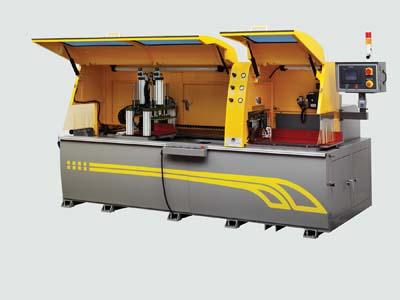
Pat Mooney Inc. — The Saw Company has added to its line the PMI-455 Series of CE NC Automatic High Production Cutoff Saws for aluminum and other non-ferrous metals. The PMI-455 is equipped with a range of features to ensure highly productive and precise performance.
For maximum stability of the saw blade during the sawing operation, the PMI-455's saw blade feed is driven by a hydraulic system. This is especially beneficial when cutting solid or heavy walled extrusions/tubes. The saw blade travels horizontally through the material and is mounted on linear guide ways. The saw head travels on the linear guide ways for accurate cutting of large materials.
For a smooth finish, the PMI-455 includes a specially designed saw worktable that moves 2mm forward as well as backward after the cut is complete and the saw blade is retracting. This feature prevents scratches from occurring when the saw blade retracts back to its home position. To prevent distortion of thin wall profiles, the PMI-455 features a pneumatic clamping system with adjustable clamping pressure. The carriage vise has two vertical and two horizontal clamps, rendering it capable of clamping irregular shaped pieces of material without any additional features. The fixed vise has two vertical and one horizontal clamp to ensure the part is clamped securely during the cutting operation. Clamps can be adjusted based on material size. The PMI-455's extensive clamping system enables the cutting of multiple, bundled pieces at one time.
The PMI-455's precise Micro-Drip Blade Lubrication System releases a small amount of lubricant to the air line at the point of discharge for control and economical distribution of the saw lubricant.
PMI-455 cutoff programs are managed with Mitsubishi NC controls. An operator-friendly touch screen allows for easy input of the desired cut length, number of pieces, blade speed and more. The machine then monitors cutoff jobs for accuracy. One hundred programs can be stored with up to 12 steps.
For safety, PMI-455 CutOff Saws are equipped with a safety enclosure monitored by limit switches. The machine cover must be closed for the saw to cycle. The saw blade access door is also protected via a limit switch. In the event that the door is opened while the saw is in operation, the machine will shut down and the saw blade will not cycle.
Two types of PMI-455 Production Saws are available. The compact Type A Upcut Saw features a design where the saw travels through the workpiece from under the worktable. Its 10 HP motor and 3200 RPM saw blade speed enable quick and precise sawing of lighter aluminum extruded shapes. Type A machine dimensions are 98.5" x 51.25" x 79.5". The Type L Horizontal Saw features a design where the saw travels horizontally on linear guideways for maximum speed. The 15 HP motor of the Type LE allows for sawing of extrusions and tubes; the 20 HP motor of the Type LS enables sawing of solid bars and extruded shapes. The Type L features variable saw blade speeds of 1500 to 3500 RPM. Type L machine dimensions are 138" x 82.67" x 73.23".
Contact Details
Related Glossary Terms
- cutoff
cutoff
Step that prepares a slug, blank or other workpiece for machining or other processing by separating it from the original stock. Performed on lathes, chucking machines, automatic screw machines and other turning machines. Also performed on milling machines, machining centers with slitting saws and sawing machines with cold (circular) saws, hacksaws, bandsaws or abrasive cutoff saws. See saw, sawing machine; turning.
- feed
feed
Rate of change of position of the tool as a whole, relative to the workpiece while cutting.
- numerical control ( NC)
numerical control ( NC)
Any controlled equipment that allows an operator to program its movement by entering a series of coded numbers and symbols. See CNC, computer numerical control; DNC, direct numerical control.
- sawing
sawing
Machining operation in which a powered machine, usually equipped with a blade having milled or ground teeth, is used to part material (cutoff) or give it a new shape (contour bandsawing, band machining). Four basic types of sawing operations are: hacksawing (power or manual operation in which the blade moves back and forth through the work, cutting on one of the strokes); cold or circular sawing (a rotating, circular, toothed blade parts the material much as a workshop table saw or radial-arm saw cuts wood); bandsawing (a flexible, toothed blade rides on wheels under tension and is guided through the work); and abrasive sawing (abrasive points attached to a fiber or metal backing part stock, could be considered a grinding operation).
- sawing machine ( saw)
sawing machine ( saw)
Machine designed to use a serrated-tooth blade to cut metal or other material. Comes in a wide variety of styles but takes one of four basic forms: hacksaw (a simple, rugged machine that uses a reciprocating motion to part metal or other material); cold or circular saw (powers a circular blade that cuts structural materials); bandsaw (runs an endless band; the two basic types are cutoff and contour band machines, which cut intricate contours and shapes); and abrasive cutoff saw (similar in appearance to the cold saw, but uses an abrasive disc that rotates at high speeds rather than a blade with serrated teeth).
